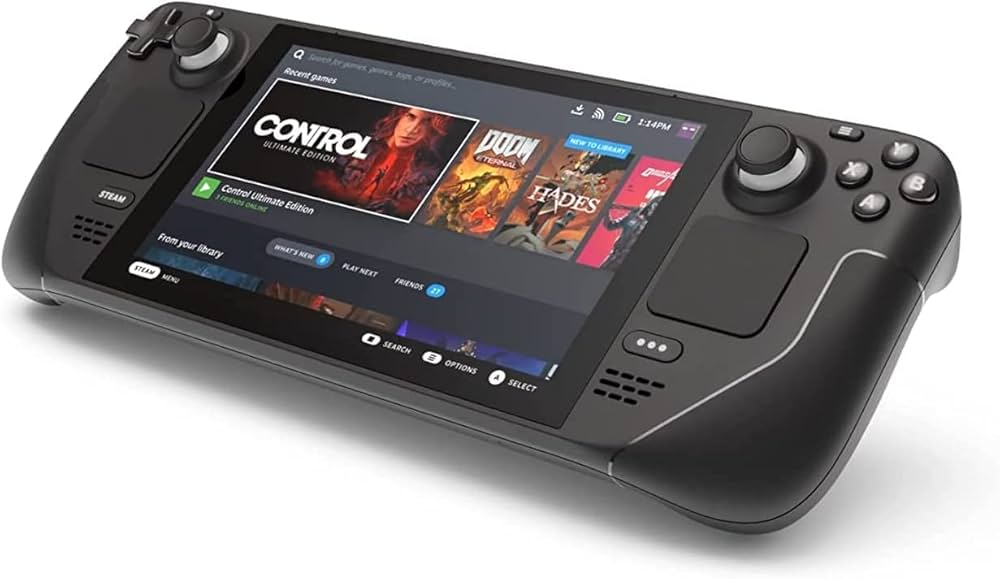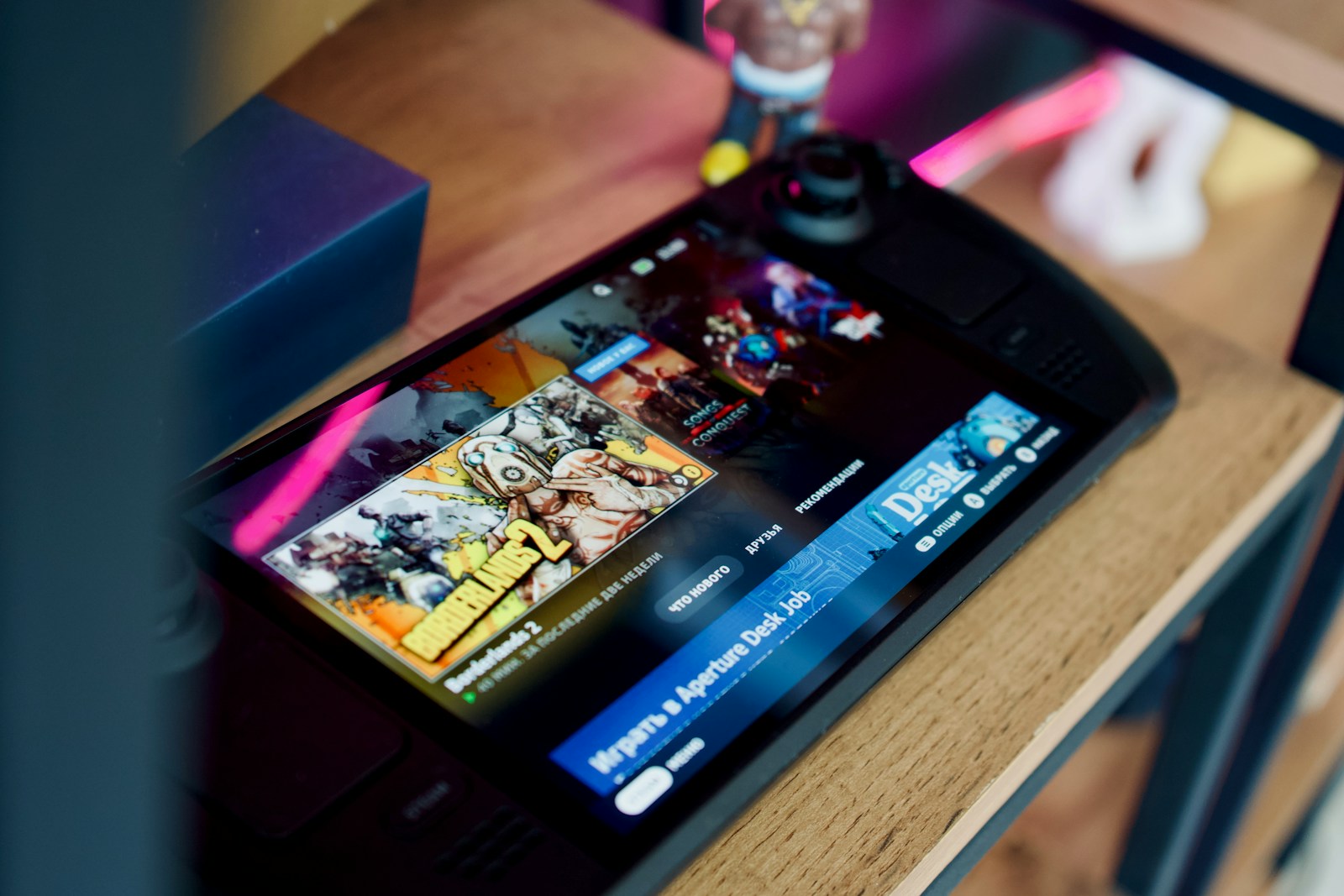The Steam Deck has changed how we play games on the go. This small but strong device lets us take our PC games anywhere. It’s like a laptop and game console in one.
Valve made the Steam Deck to bring PC gaming to a handheld format. The Steam Deck runs on SteamOS, a Linux-based system that can play most PC games. It works with Steam’s huge game library. Plus, it has controls like a regular game console.
Setting up a Steam Deck is easy. Turn it on, log in to your Steam account, and start playing. But there’s more to learn. You can change settings, add storage, and even use it like a mini PC. With some tips, you can make your Steam Deck even better.
Steam Deck: A Comprehensive Guide
Understanding the Steam Deck
The Steam Deck is a portable PC gaming console developed by Valve. It allows you to play your Steam library on the go. Think of it as a handheld PC that runs a customized Linux-based operating system called SteamOS. This OS is designed to work seamlessly with the Steam platform. The Deck has built-in controls, a touchscreen, and can even be connected to a monitor, keyboard, and mouse for a more traditional PC gaming experience. It’s essentially a bridge between the convenience of console gaming and the vast library of PC games.
Steam Deck Models: OLED vs. LCD

Valve offers the Steam Deck in two primary models: the original LCD version and the newer OLED version. Here’s a comparison:
| Feature | Steam Deck (LCD) | Steam Deck OLED |
|---|---|---|
| Display | LCD | OLED |
| Brightness | 400 nits | 1000 nits (HDR) |
| Refresh Rate | 60Hz | 90Hz |
| Battery Life | 2-8 hours | 3-10 hours |
| Storage | 64GB, 256GB, 512GB NVMe SSD | 512GB, 1TB NVMe SSD |
| Weight | 669 grams | 640 grams |
| Price (USD) | Starting at $399 | Starting at $529 |
The OLED version offers significant improvements, including a more vibrant display, better battery life, and a slightly lighter design. However, the LCD version is still a capable machine and a more affordable option. Choosing between the two depends on your budget and how much you value the improved features of the OLED model.
Features and Functionality
- Portability: The Steam Deck’s primary appeal is its portability. You can play your PC games anywhere.
- SteamOS: SteamOS provides a user-friendly interface optimized for gaming.
- Game Compatibility: A large and growing number of PC games are compatible with the Steam Deck. Valve has a verification system that categorizes games based on their playability on the device.
- Customization: SteamOS is highly customizable, allowing you to tweak settings and personalize your experience.
- Community Support: The Steam Deck has a vibrant community that creates mods, shares tips, and provides support.
Tips and Tricks for Steam Deck Owners
- Optimize Game Settings: Adjusting in-game settings can significantly improve performance and battery life.
- Use the Steam Community: Explore the Steam Community for game-specific tips and configurations.
- Expand Storage: Consider upgrading the internal storage or using a microSD card to store more games.
- Explore Proton: Proton is a compatibility layer that allows many Windows games to run on SteamOS. Experiment with Proton settings to improve compatibility.
- Update SteamOS: Keep SteamOS updated to benefit from performance improvements, new features, and bug fixes.
Steam Deck’s Impact on Portable Gaming
The Steam Deck has shaken up the portable gaming market. It offers a unique combination of PC gaming power and console-like portability. Its success has encouraged other companies to explore similar devices, creating more choices for consumers. The Steam Deck has also broadened the reach of PC gaming, making it more accessible to people who prefer the convenience of handheld consoles.
Beyond Gaming: Other Uses for Your Steam Deck
While primarily a gaming device, the Steam Deck’s versatility extends beyond playing games. Because it’s essentially a PC, you can use it for other tasks, such as:
- Web Browsing: Use the Steam Deck’s desktop mode to browse the web.
- Media Consumption: Watch videos or stream movies on the go.
- Light Productivity: Perform basic productivity tasks, such as writing documents or checking email.
- Emulation: Play retro console games through emulation.
The Future of Steam Deck and Portable PC Gaming
The Steam Deck’s success has paved the way for the future of portable PC gaming. We can expect to see more powerful and refined handheld gaming PCs in the coming years. Improvements in hardware, software, and game development will continue to enhance the portable gaming experience. The Steam Deck has proven that there’s a strong demand for powerful and portable PC gaming devices, and this trend is likely to continue.
Comparing Steam Deck to Other Handheld Consoles
While the Steam Deck is a unique device, it’s worth considering how it compares to other handheld gaming options:
- Nintendo Switch: The Switch is more focused on console-quality games and offers a hybrid experience (handheld and docked). It has a larger library of exclusive titles.
- AYANEO and Other PC Handhelds: Several companies produce other handheld PCs that run Windows. These often offer more powerful hardware but can be more expensive.
The best choice depends on your priorities. If you want access to Nintendo exclusives, the Switch is the way to go. If you want the most powerful handheld PC, other Windows-based devices might be a better fit. But if you want a balance of portability, game library, and price, the Steam Deck remains a compelling option.
Understanding SteamOS and Proton
SteamOS is the Linux-based operating system that powers the Steam Deck. It’s designed to provide a smooth and optimized gaming experience. Proton is a compatibility layer that allows many Windows games to run on SteamOS. It’s a key component of the Steam Deck’s success, as it enables access to a vast library of PC games. Valve actively develops and improves both SteamOS and Proton, ensuring better game compatibility and performance over time.
Key Takeaways
- The Steam Deck is a handheld PC gaming device made by Valve
- It runs SteamOS and can play most Steam games
- Users can customize settings and add storage to improve their experience
Getting Started with Your Steam Deck
The text discusses opportunities for gaming on the go beyond the Steam Deck. It highlights cloud gaming services like Xbox Game Pass Ultimate and GeForce Now, which allow streaming games on various devices without needing powerful hardware.
Additionally, it mentions the rise of mobile gaming, offering a range of games designed for handheld devices, providing a convenient way to game while mobile. Exploring these options can enhance gaming experiences while on the move.
The Steam Deck is a powerful handheld gaming device. It offers a unique gaming experience with its portable design and PC-like capabilities.
Understanding Steam Deck’s Hardware
The Steam Deck has a 7-inch touch screen. It runs on a custom AMD processor with 16GB of RAM. The device comes with different storage options, from 64GB to 512GB.
It has many controls. These include thumbsticks, buttons, and trackpads. There’s also a USB-C port for charging and connecting accessories.
The battery life varies based on use. It can last 2-8 hours on a single charge. The Steam Deck supports Wi-Fi and Bluetooth for connectivity.
Setting Up Your Steam Deck
Turn on the Steam Deck by pressing the power button. Follow the on-screen setup guide. You’ll need to connect to Wi-Fi and sign in to your Steam account.
If you don’t have a Steam account, you can make one during setup. The device will then check for and install any updates.
After setup, you can start downloading games. You can also connect a Bluetooth keyboard or mouse if you want.
Navigating the SteamOS Interface
SteamOS is the operating system on the Steam Deck. The main screen shows your game library and store. You can use the touch screen or buttons to navigate.
Press the Steam button to open the Quick Access Menu. Here you can adjust settings like brightness and volume. The menu also has shortcuts to your friends list and notifications.
For more options, go to the Settings Menu. You can manage storage, change display settings, and more here. There’s also a Desktop Mode for a more PC-like experience.
Enhancing Your Gaming Experience
The Steam Deck offers many ways to boost your gaming fun. You can tweak settings, add extras, and play games from other stores.
Optimizing Game Performance
SteamOS lets you change graphics settings for each game. You can lower the quality to get smoother gameplay. Or you can raise it for better looks. The Steam Deck also has a frame rate limiter. This helps save battery life.
Some games work better than others on Steam Deck. Check ProtonDB to see how well a game runs. This site rates games based on how they play on Steam Deck.
You can add an SD card for more storage. This is great for big game files. But the built-in storage is faster, so save your favorite games there.
Customization and Accessories
You can make your Steam Deck your own. Change the home screen layout or add new themes. Pick your favorite games to show up first.
A screen protector is a smart buy. It guards against scratches and smudges. Many users also get a carry case to keep their Deck safe.
For longer play sessions, try a USB-C hub. This lets you connect to a TV or monitor. You can use a full-size keyboard and mouse too. Some players like using other controllers with their Deck.
Playing Non-Steam Games
The Steam Deck can run more than just Steam games. You can add games from Epic, GOG, or other stores. Use apps like Heroic or Lutris to help set these up.
Emulators let you play old console games on your Deck. Make sure you only use ROMs you own to stay legal.
Windows games often work through Proton. This tool helps run Windows software on Linux. Not all games work perfectly, but many do. If a game won’t run, check online for fixes or tweaks.







